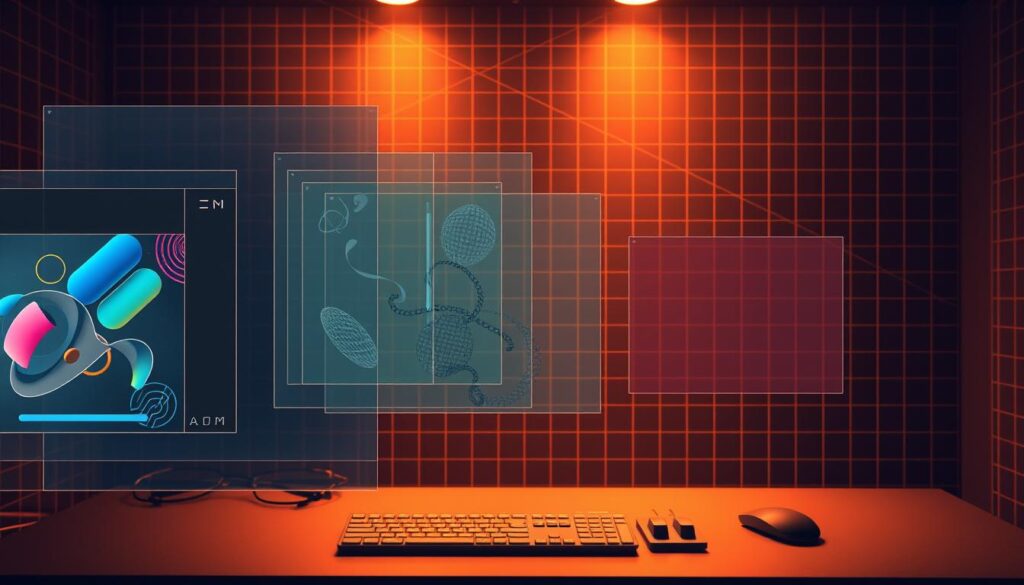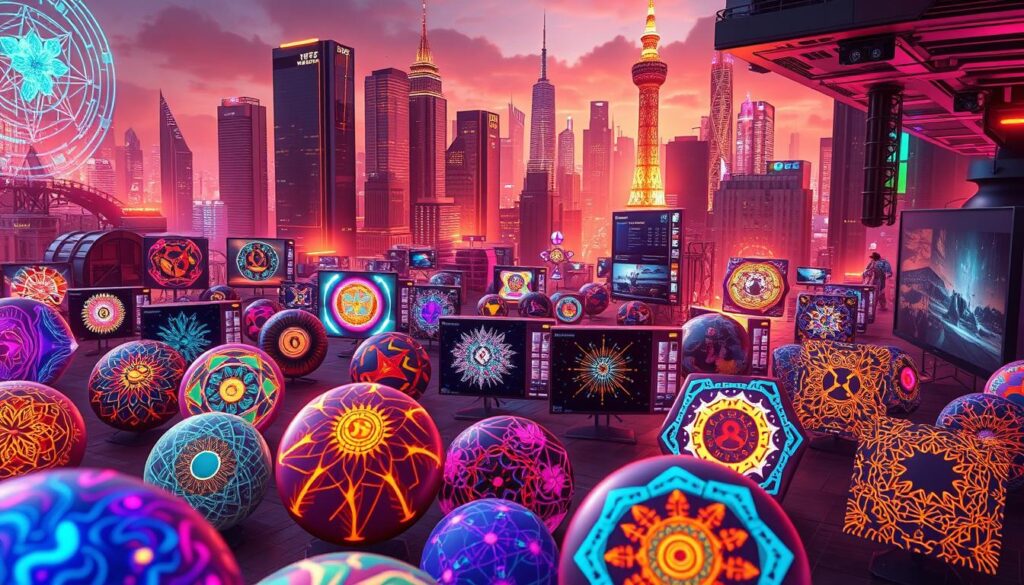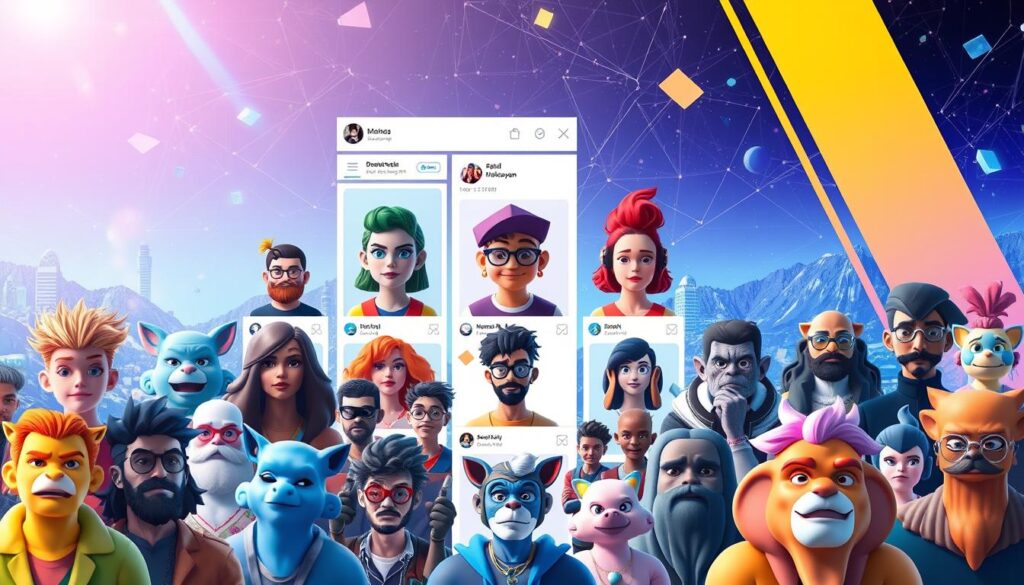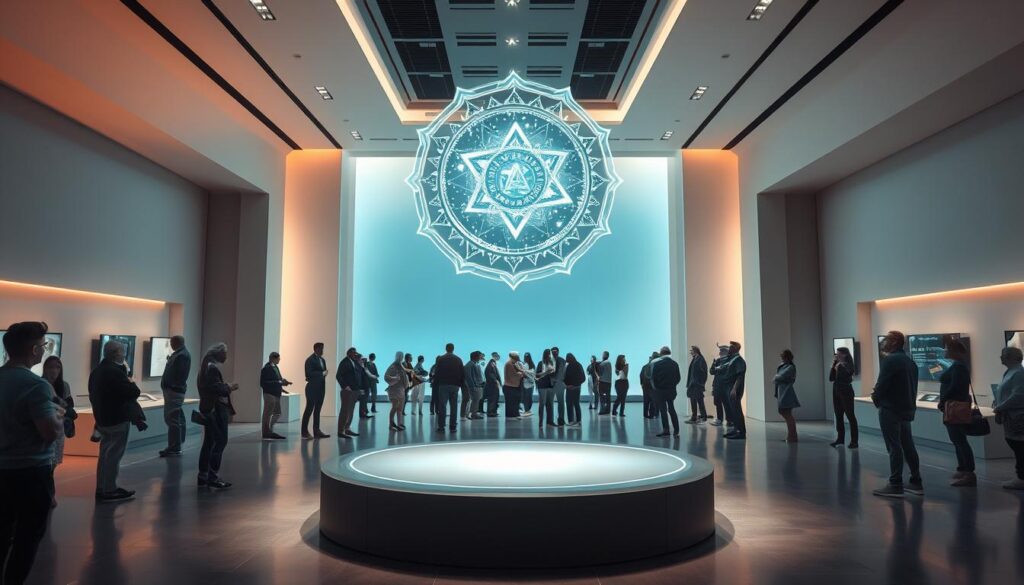Now Reading: Understanding NFT Generative Art Algorithm Creation Process
- 01
Understanding NFT Generative Art Algorithm Creation Process
Understanding NFT Generative Art Algorithm Creation Process

This comprehensive guide explores the complete journey of building digital collectibles through automated systems. Many creators are discovering how to produce thousands of unique pieces without manually drawing each one.
The process represents a fascinating intersection where artistic vision meets coded automation. It allows designers to maintain creative control while leveraging technology’s efficiency.
Readers will discover the fundamental components that power these innovative systems. Layers, traits, weights, and rules work together to create diverse yet harmonious collections.
This resource serves as an essential starting point for anyone looking to launch their own digital collection. It combines theoretical knowledge with practical implementation strategies drawn from real-world examples.
Key Takeaways
- Learn how automated systems can produce thousands of unique digital pieces
- Discover the intersection between artistic vision and technical implementation
- Understand the components that create both uniqueness and cohesion in collections
- Gain practical insights from real-world implementations and case studies
- Master the workflow suitable for both technical developers and creative designers
- Learn to maintain complete control over rarity distributions and aesthetic outcomes
- Access actionable strategies for launching your own digital collection project
Introduction to Generative Art and NFT Trends
Long before digital ownership became possible through blockchain, artists were already exploring systematic approaches to creative expression. The foundations of today’s digital collectibles trace back to mid-20th century innovations.
The Evolution of Generative Art
This artistic approach emerged during the 1950s and 1960s, well before internet technology. Pioneers like Ellsworth Kelly created groundbreaking works using chance-based methods.
His 1951 piece “Spectrum colours arranged by chance II” established principles that would influence future digital practices. Despite its innovation, this method remained peripheral to mainstream movements for decades.
NFT Revolution Explained
The contemporary resurgence began around 2017 when blockchain technology enabled new authentication methods. This provided artists with mechanisms for ownership verification and monetisation.
By 2021, the market for digital assets reached $25 billion in sales. Even during 2022’s crypto downturn, transactions maintained remarkable resilience at $24.7 billion.
| Aspect | Historical Period (1950s-60s) | Contemporary Era (2017-present) |
|---|---|---|
| Timeline | Pre-internet era | Blockchain technology era |
| Key Figures | Ellsworth Kelly and other pioneers | Digital artists and developers |
| Artistic Approach | Chance-based methods | Algorithmic systems with verification |
| Market Impact | Peripheral to mainstream art | $25+ billion global market |
This convergence of decades-old practices with cutting-edge technology has created unprecedented opportunities for creative professionals worldwide.
What is a Generative Art Algorithm?
Contemporary digital artists are increasingly turning to systematic methods that blend human creativity with computational efficiency. This approach represents a significant departure from traditional manual techniques.
Defining the Core Concept
At its essence, this computational method functions as an autonomous framework. It enables creators to establish parameters and rules that guide the production of visual outputs.
The system incorporates mathematical principles and geometric relationships. This ensures each output maintains aesthetic coherence while offering unique variations.
Randomness serves as the defining characteristic of this approach. Without unpredictable elements, the results would be entirely predetermined by the creator.
Understanding Key Components
Several essential elements work together within these systems. Input parameters define the boundaries of possible outcomes.
Rule structures govern how different elements interact. Randomisation methods introduce the necessary unpredictability for genuine uniqueness.
Output rendering translates the computational process into final visual forms. Each component must be carefully balanced to achieve the desired artistic results.
This collaborative process between human vision and automated systems opens up creative possibilities that would be impractical through manual methods alone.
NFT generative art algorithm creation: Components and Workflow
Building a successful digital collectibles project requires a meticulous, step-by-step approach that balances creativity with technical precision. This systematic method ensures every piece in the collection maintains visual harmony while offering genuine uniqueness.
The workflow begins with artists developing foundational visual elements. These layers establish the core visual vocabulary for the entire series.
Automated Art Creation
After layer creation, teams determine how elements stack together. This critical decision affects how final compositions appear.
Rarity calculations are then applied to individual traits. This mathematical approach creates the scarcity that drives collector interest.
Rule implementation prevents visually incompatible combinations while allowing for creative variations. These guidelines ensure aesthetic consistency across all outputs.
The generation phase automatically produces images with corresponding documentation. This simultaneous creation streamlines the entire process.
Finally, the documentation integrates with blockchain technology. This creates permanent connections between each token and its unique characteristics.
| Approach | Manual Creation | Automated System |
|---|---|---|
| Production Scale | Limited to dozens of pieces | Thousands of unique items |
| Consistency Control | Challenging to maintain | Built into the system |
| Rarity Tracking | Manual record-keeping | Automated probability settings |
| Metadata Management | Separate documentation | Integrated file generation |
This automated method solves the practical challenge of manually creating thousands of distinct images. It allows creators to focus on system design rather than repetitive execution.
The Role of Layers in NFT Art
Visual composition in digital collectibles relies heavily on a systematic approach to layer management. Each component of the final image represents a distinct layer that combines with others to create complete pieces.
Importance of Organising Layers
Proper organisation requires careful advance planning. Creators must determine which visual elements constitute separate layers.
These range from foundational components like body shapes to decorative elements. Clothing, accessories, and special effects each need their own designated space.

Best Practices in Layer Order
The stacking sequence determines how visual elements overlay and interact. This order must remain fixed throughout development to prevent alignment issues.
A typical progression starts with background elements. It then builds through foundational features, clothing, and finally front-facing accessories.
Some layers may appear multiple times to accommodate duplicate traits. This ensures proper depth relationships across the entire series.
| Practice | Good Approach | Poor Approach |
|---|---|---|
| Planning | Define all layers in advance | Add layers as needed during creation |
| Order Consistency | Maintain fixed stacking sequence | Change order during development |
| Duplicate Handling | Allow multiple layer instances | Restrict traits to single appearance |
| Visual Harmony | Test combinations thoroughly | Assume all combinations will work |
Meticulous organisation ensures every generated combination displays correctly. This prevents elements from appearing incorrectly positioned within the final composition.
Defining Traits and Their Weights
At the heart of every distinctive digital series lies the strategic organisation of visual elements and their appearance frequencies. This systematic approach ensures each piece maintains uniqueness while contributing to the overall aesthetic harmony.
Proper trait definition forms the foundation for creating compelling visual diversity within any artistic project. Each characteristic variation contributes to the final composition’s individuality.
Establishing Variation in Traits
Traits represent the specific options available within each visual category. An eye layer, for instance, might include various colour options like blue, green, grey, brown, black, and purple.
File naming conventions provide essential organisational clarity. A structured format such as “clothing—ruffle-turtleneck-yellow-#1.png” communicates all necessary information efficiently.
This naming system identifies the layer, describes the trait characteristics, and includes weight data. It enables seamless processing during the generation phase.
Setting Accurate Weights
Weights determine rarity distribution by assigning numerical values to each trait. These values represent how frequently characteristics appear relative to others in the same category.
The weight system offers practical advantages over percentage-based approaches. Using whole numbers simplifies implementation and avoids computational complexity.
For example, if brown eyes should be common and pearl-purple-metallic eyes rare, you might assign weights of 50 and 1 respectively. This makes brown eyes fifty times more likely to appear.
| Weight System | Advantages | Implementation Complexity | Rarity Precision |
|---|---|---|---|
| Whole Number Weights | Simple calculations | Low | High (exact ratios) |
| Decimal Percentages | Familiar format | Medium | Medium (rounding issues) |
| Fractional Values | Mathematical purity | High | High (complex handling) |
This approach allows creators to work with intuitive ratios while maintaining precise control over rarity distribution throughout their artistic project.
Establishing Rules for Generative NFT Collections
Rule implementation stands as the decisive factor in maintaining aesthetic consistency throughout large-scale digital art projects. These logical frameworks transform random combinations into cohesive visual experiences.

The governance system for trait combinations determines whether a series achieves professional polish. Without proper constraints, outputs may appear randomly assembled rather than intentionally designed.
Developing Consistent Rules
Rules constitute the backbone of successful automated production systems. They ensure visual harmony across thousands of unique pieces while preserving each item’s individuality.
This process requires iterative refinement as initial guidelines often need adjustment. Test generations frequently reveal unexpected combinations that either enhance or detract from the overall aesthetic.
Effective rule development combines technical precision with artistic sensibility. Creators must understand their community’s expectations while maintaining clear vision alignment.
A basic rule might check for specific trait combinations using conditional logic. For example, verifying whether “clothing—ruffle-turtleneck-yellow” and “jewelry-face—glasses” coexist before approving the output.
More advanced approaches apply broader category checks rather than targeting exact filenames. This allows rules to govern all turtleneck variations regardless of specific colours or styles.
The combination of multiple rules creates a sophisticated framework that guides the system toward aesthetically successful outcomes. This balance ensures coherence while allowing for delightful surprises.
Step-by-Step Creation of a NFT Generative Art Algorithm
The transformation from individual artwork to complete digital series requires meticulous planning and iterative refinement. This systematic approach ensures every piece maintains visual coherence while offering genuine uniqueness.
Workflow Planning
Begin by establishing a clear sequence from background elements to foreground details. Proper layer ordering creates the foundation for successful combinations.
Trait definition follows with systematic naming conventions. This organisation allows the system to correctly interpret each visual element during generation.
Testing Your Algorithm
The generation phase is inherently iterative, requiring multiple test runs. Each iteration reveals both successful combinations and problematic pairings.
Artists should embrace this testing process as an opportunity for discovery. Running the system numerous times helps refine parameters until outputs align with the creative vision.
This methodical approach to building digital collections ensures professional results. Patience during refinement leads to closer achievement of the dream series.
Generating Images and Metadata Automatically
The digital production process extends beyond visual creation to include comprehensive data documentation for each unique piece. This simultaneous generation ensures every item receives proper identification without manual intervention.

Automated metadata linkage forms the backbone of efficient digital series management. Systems produce structured files containing essential information for proper item tracking.
Automated Metadata Linkage
Metadata structures follow standardised formats that include unique identifiers and detailed descriptions. Each file contains an attributes array listing specific characteristics using trait_type and value pairs.
For example, a complete metadata file might document “Background: Pale Blue” alongside “Eyes: Blossom Pink” specifications. This systematic approach creates clear documentation for thousands of items.
IPFS storage provides permanent, decentralised access to these metadata files. The system generates unique content addresses that remain accessible regardless of individual server status.
Smart contract integration completes the linkage process. Contracts establish base URI connections pointing to metadata locations, enabling proper token identification.
This entire system conforms to ERC721 standards expected by marketplaces and collectors. The automated approach ensures scalability while maintaining data integrity throughout the collection.
Integrating Smart Contracts for NFT Collections
Smart contracts serve as the critical infrastructure that transforms digital artwork into verifiable blockchain assets. These self-executing programmes create the permanent connection between visual creations and their on-chain identities.
The integration process establishes the foundation for proper ownership tracking and metadata accessibility. It represents the final technical step before a collection becomes publicly available.
Understanding Smart Contract Integration
Metadata linkage forms the core function of these contracts. Through standardised functions like setBaseURI, contracts establish permanent pointers to artwork characteristics.
This system accepts parameters specifying metadata locations, typically using IPFS hashes. The _baseTokenURI variable creates the essential bridge between token numbers and their corresponding traits.
ERC721 compliance ensures marketplace compatibility across the ecosystem. Contracts must implement expected interfaces for proper display and interaction.
Beyond metadata management, these programmes handle the minting logic. They execute token creation and transfer ownership directly to collectors upon transaction confirmation.
This creates an immutable record that cannot be altered after deployment. The provenance and characteristics of each asset remain permanently verifiable.
Careful contract development prevents security vulnerabilities and functional issues. Understanding this integration allows creators to maintain greater control over their projects.
Leveraging Code for Creative NFT Development
Translating artistic vision into functional digital systems requires a specific set of coding skills. Developers must bridge the gap between creative concepts and technical execution for a successful project.
This process involves writing logic that handles visual element selection and combination. The right approach ensures both uniqueness and coherence across the entire series.
Effective Coding Techniques
JavaScript serves as the primary language for building these systems. It offers frameworks like p5.js that simplify visual output generation.
The core logic calculates a total weight for all traits in a layer. It then picks a random number within that range to make a selection.
Effective code iterates through elements, subtracting weights until the random value turns negative. This indicates the chosen trait for that specific layer in the final output.
Open-source examples from ProsePoetryCode provide excellent reference material. These foundations help developers understand the essential structure for their own work.
Troubleshooting Common Issues
Testing is crucial for identifying problems in the generation process. Developers should run sample sets repeatedly to spot mismatched combinations.
Common technical challenges include managing rarity calculations without decimal complexity. Using integer weights instead of percentages offers a simpler solution.
Layer order consistency prevents visual misalignment between traits. Establishing rigid naming conventions and canvas standards helps maintain proper positioning.
Refining rules through iterative testing addresses aesthetic failures. This careful approach transforms subjective judgement into objective logical conditions the system can evaluate.
Real-World Examples of Generative NFT Projects
Several prominent series demonstrate the diverse possibilities of systematically produced visual assets. These projects showcase how computational approaches can achieve both artistic excellence and commercial success.
Surge Passport Case Study
The Surge Passport collection created 5,000 unique portraits celebrating diverse women worldwide. Artist Kiri developed initial character sketches before the team expanded the drawings and built the generation system.
Significant effort went into rarity weighting to ensure accurate global representation. This focus on inclusivity distinguished the project from others prioritising mere visual appeal.
Other notable examples include Chromie Squiggles by Art Blocks founder Erick Calderon. This project became an iconic symbol of the entire on-chain movement.
Tyler Hobbs’ Fidenza series represents one of the most celebrated systems. Individual outputs regularly command prices exceeding $1 million.
These real-world illustrations reveal the aesthetic range possible with computational methods. From abstract compositions to representational portraiture, they share permanent on-chain existence.
The Impact of Generative Art on Digital Collecting
Digital ownership models have evolved significantly, creating new paradigms for how artistic works are collected, valued, and shared globally. This transformation introduces verifiable scarcity to a medium once characterised by infinite reproducibility.

Blockchain technology provides collectors with unprecedented benefits. These include permanent provenance records and complete ownership transparency.
The digital nature enables instant global transfers without physical logistics. Unlike traditional pieces that deteriorate, digital works maintain perfect condition indefinitely.
This approach separates consumption from ownership. Anyone can view perfect renderings while ownership remains secure in digital wallets.
Collecting generative art means appreciating both the output and the creative system. The code framework holds cultural significance beyond individual pieces.
| Aspect | Traditional Art Collecting | Digital Art Collecting |
|---|---|---|
| Provenance Verification | Paper documentation, expert appraisal | Blockchain records, permanent verification |
| Condition Maintenance | Environmental risks, deterioration | Perfect preservation, no degradation |
| Market Accessibility | Geographic limitations, physical barriers | Global access, instant transactions |
| Community Engagement | Local galleries, physical events | Digital platforms, global communities |
The generative art community functions as a digitally native network. It brings together diverse subcultures united by shared artistic values.
Balancing Artistry and Algorithm: Tips for Artists
The most successful digital projects emerge when technical precision and creative intuition work in harmony. This delicate balance requires artists to develop dual competencies that blend aesthetic sensibility with systematic understanding.
Fusing Creativity with Code
As noted by Tyler Hobbs, this form of artistic expression works with the essential building blocks of our digital worlds. Many creators find that writing rules feels surprisingly non-technical when approached creatively.
Successful projects typically involve dedicated teams combining diverse skills. Visual specialists establish aesthetic direction while developers implement technical systems.
The rule-writing process exemplifies this fusion perfectly. It requires artistic judgement about aesthetics alongside cultural awareness about representation.
Artists should maintain clear vision throughout development. This creative north star guides technical decisions and ensures complexity serves artistic goals.
Understanding community context proves equally important. Digital collections exist within social ecosystems where collector preferences significantly influence reception.
This approach opens vast possibilities for discovery. Systematic generation can reveal unexpected combinations that manual methods might never uncover.
Future Trends in NFT Generative Art and Digital Assets
The evolution of digital collectibles continues to accelerate, with emerging technologies reshaping how artists and collectors interact with creative works. The landscape for these assets is transforming rapidly as new tools and platforms emerge.
Innovative Trends
Artificial intelligence integration represents the next frontier for creative systems. Machine learning technologies enable more sophisticated approaches to visual generation.
Generative Adversarial Networks (GANs) allow systems to learn from extensive datasets. They can produce original images that reflect learned patterns while introducing unique variations.
Natural language interfaces are becoming more prevalent in the creative process. Artists can use keywords and phrases to guide AI systems through vast art historical repositories.
Market Predictions
The sector shows strong potential for continued growth despite market fluctuations. Verifiable ownership and algorithmic creativity appeal to expanding collector demographics.
Art Blocks has established itself as the premier platform for on-chain generative works. Its standards for technical implementation and curation influence the broader ecosystem.
On-chain storage is transitioning from innovative feature to expected standard. This ensures artwork permanence independent of external hosting services.
| Trend Category | Current State | Future Direction |
|---|---|---|
| Technology Integration | Basic algorithmic systems | AI and neural networks |
| Storage Solutions | Mixed (IPFS/centralised) | Full on-chain standard |
| Platform Development | Multiple emerging platforms | Established leaders with standards |
| Collector Engagement | Static image collections | Interactive and evolving works |
Future developments may include greater interactivity and integration with virtual environments. Time-based works that evolve based on external inputs represent another exciting direction.
Challenges and Solutions in NFT Generative Art Algorithm Creation
Developing systematic digital projects inevitably encounters various technical hurdles that demand careful problem-solving. Teams must navigate computational complexities while preserving aesthetic harmony across thousands of outputs.
Common Technical Challenges
Managing rarity calculations presents persistent difficulties with decimal number complexity. Many creators struggle with percentage-based systems that complicate coding and file organisation.
Layer order consistency often breaks when artists add new traits during development. This can disrupt visual composition and require significant reworking.
Pixel-level misalignment occurs when different team members create assets without strict positional standards. These inconsistencies undermine the professional quality of the final collection.
Effective Solutions
Integer-based weight systems provide cleaner alternatives to percentage calculations. They achieve equivalent probability distributions without decimal complications.
Establishing rigid naming conventions and documentation practices prevents layer sequence issues. Teams should maintain version control throughout the development process.
Running extensive test generations identifies problematic trait combinations before final deployment. This iterative approach allows for rule refinement based on observed results.
Conditional logic that only applies rules when relevant traits exist improves efficiency. It maintains aesthetic control while reducing unnecessary regeneration attempts.
Conclusion
As we reach the culmination of this exploration, it becomes clear that systematic artistic production represents more than just technical innovation. This methodology brings together creative vision and computational precision in a powerful way that enables artists to produce thousands of unique works while maintaining aesthetic harmony.
The entire workflow—from initial concept through layer organisation to final integration—demonstrates how diverse skills must collaborate. Successful projects require teams combining artistic direction, technical implementation, and rigorous testing. Real-world examples show the remarkable possibilities available through this approach.
While challenges exist, systematic problem-solving and iterative refinement help creators overcome obstacles. Most importantly, artists should remember to enjoy the discovery process. The journey of computational art is just beginning, promising exciting new chapters in our digital world.
Don’t forget to have fun with your creative journey! This field continues evolving with incredible potential ahead.
FAQ
What exactly is a generative art algorithm?
A generative art algorithm is a set of coded instructions that automatically creates visual pieces. It uses rules and randomness to produce unique artworks, often for digital collections like those on platforms such as Art Blocks. The process blends artistic vision with computational logic.
How do traits and rarity function in a digital collection?
Traits are distinct features, like colour or style variations, that make each piece in a collection unique. Rarity is controlled by assigning weights to these traits, determining how often they appear. This system ensures some digital assets are more uncommon than others, adding value.
What is the role of a smart contract in this process?
A smart contract is a self-executing contract on a blockchain that manages the minting and ownership of digital assets. It links the artwork’s metadata to the token, ensuring provenance and automating the distribution of the collection’s pieces.
Can you explain the importance of organising layers?
Properly organising layers is crucial for the algorithm to combine visual elements correctly. The order in which layers are stacked dictates how features interact, preventing visual errors and ensuring the final output matches the artist’s intended style and composition.
What are some common challenges artists face?
Artists often encounter technical issues like code errors or metadata misalignment. Balancing creative control with the algorithm’s randomness can also be difficult. Effective testing and community feedback are key solutions for refining the final collection.
How does generative art impact the world of digital collecting?
It introduces a new paradigm where collectors can own provably unique assets created by a system. This fusion of art and technology fosters a strong community around collections and pushes the boundaries of what is considered collectible in the digital space.














